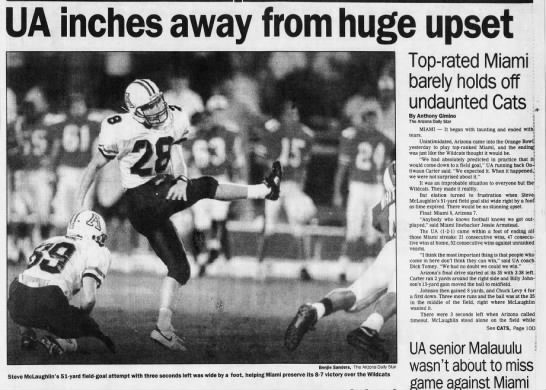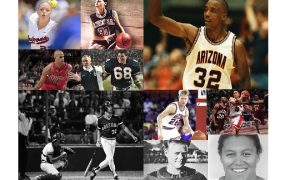An Arizona Daily Star headline the day Arizona played at No. 1 Miami on Sept. 26, 1992, read: “UA has no chance against Hurricanes.”
Las Vegas oddsmakers had the Hurricanes as 27.5-point favorites, which was about their margin of victory — 36-7 –the year before over the Wildcats at Arizona Stadium.
Arizona was 1-1-1 coming off a humbling tie at Oregon State, a team that would go on to win only one game that season. Miami was 2-0 riding a 46-game home winning streak.
Darryl Morrison, a senior cornerback, remembers vividly the type of flippant reception the Wildcats received when they arrived at the Orange Bowl to play the game 25 years ago today.
“We weren’t intimidated by the the police officers laughing at us while sitting on their horses as they lined both sides of the tunnel when we entered the stadium to the locker room,” Morrison communicated to me yesterday. “We weren’t intimidated by their players sitting in the stands with the fans during pregame.
“We weren’t intimidated by them taunting us pregame. We sure weren’t intimidated when they tried to meet us centerfield. That wasn’t happening.”

Players from Arizona and Miami stand off at midfield before the game, an indication the Wildcats were not going to lay down against the No. 1 Hurricanes (Eric Johnson and UASports.net photo)
Heath Bray — a safety who started in place of injured quarterback George Malauulu — and Josh Miller received the cold shoulder from Miami captains Jessie Armstead and Kevin Williams when they tried to shake their hands after the coin toss.
“They came out and they looked at the ground and put their hands behind their backs when it came time to shake hands,” Bray said in a 2006 interview with the Tucson Citizen. “(Former UA players) Ty Parten and Charlie Camp saw that and they came bounding off the sideline, and the whole team gets right behind us, and from that point on, it was game on.”
The teams faced off against each other near midfield. The Wildcats did not back down to the mighty “U”, as Miami is called because of its helmet logo.
“They refused to look up or shake our hands before the kickoff,” Bray recounted yesterday. “Our team saw that and erupted. We came out to the middle of the field and challenged the Hurricanes. They were not ready for that.”
Former Arizona offensive lineman Eric Johnson remembered Parten giving a pregame players-only speech that riled up the Cats.
“He gave the pregame players-only scream down,” Johnson wrote in a thread at UASports.net a few years ago. “When we left that room, we knew it was gonna be a war.”
Miami’s disrespectful demeanor started in pregame warmups when Miami quarterback Gino Torretta came close enough to Bray to mention to him, “You aren’t playing quarterback today are you?”
The two exchanged pleasantries the year before in Tucson after they were on the ground following an Arizona blitz and Torretta helped Bray to his feet.
After Torretta’s arrogant remark to him before the game at Miami, Bray said he had a terse response to show the Hurricanes’ captain the Wildcats were not his punching bag.
“I told him to get back on his side as he walked away, trying to intimidate us,” Bray said.
From then to the point of the disrespect at the coin toss to the way Arizona’s defense responded from the start, the “Desert Swarm” was conceived and born that fateful day in Miami.
The root of Arizona’s success at Miami can be traced to meetings Dick Tomey had with his players after the Wildcats tied the hapless Beavers the week before they departed to Miami.
In the two days following the game with the Beavers, Tomey said he spent a total of “20 hours” talking to each player individually.
“I got eyeball-to-eyeball with them,`” Tomey is quoted as saying by the Chicago Tribune. “I wanted them to get the sense that I believed in them. We were all hurting at the time. It made me feel better. Whether it had to do with the turnaround, I don`t know.”

Arizona Daily Star clipping of Arizona’s near upset of No. 1 Miami in 1992.
Miami — which gained only two yards on 22 carries — bore the brunt of the Desert Swarm’s emergence. The Wildcats led 7-2 at halftime, and had a chance to win it, but sophomore Steve McLaughlin just missed wide right on a 51-yard attempt as time ran out. The scoreboard read 8-7 in Miami’s favor but Arizona and the Desert Swarm did not come off as losers to the big, bad Hurricanes.
“They think they put on their clothes a little differently and that they have an ‘S’ on their chest. Sorry, pal,” said Malauulu, who eventually played in the game, in an Associated Press article.
“They’re not the No. 1 team. If they were, they’d have blown us out.”
“The best example of a good loss I have ever been a part of,” Bray added. “We physically manhandled the bullies. Very proud of that team.”
Using a ball-control running game the Wildcats ran for 170 yards on 50 attempts against the Hurricanes. The Wildcats controlled the ball for nearly 35 minutes and gained an average of 4 yards per play. They passed for only 86 yards.
Miami seemed to be in for an easy afternoon when Miami All-American defensive end Rusty Medearis — who later suffered a season-ending knee injury in the game — stuffed Chuck Levy in the end zone for a safety on Arizona’s second possession.
Miami’s offense never really got on track. Hurricanes wide receiver Lamar Thomas shoved a defensive back on the next series, resulting in a penalty that pushed the Hurricanes out of field-goal range. Miami’s Dane Prewitt missed wide left from 28 yards on the next possession and from 37 yards on the one after that. An interception within Arizona territory stopped Miami’s last possession of the half.
Arizona scored its only touchdown on an 80-yard, 10-play drive dominated by the run. The Wildcats rushed nine times, culminating on Billy Johnson’s nine-yard touchdown run.
RELATED: Arizona’s Top 10 moral victories in the history of the program
Miami’s only touchdown — the game’s final points — came on Torretta’s two-yard pass to Dietrich Clausell with 3:50 to play in the third quarter.
Arizona, starting its last possession with 3:38 left in the game, drove the ball from its 35 to the Miami 35. After a quarterback sneak by Malauulu, McLaughlin lined up for his 51-yard attempt that barely missed. He also missed a 44-yarder with 21 seconds to play in Arizona’s tie the week earlier against Oregon State.
“If you take too much consolation in coming close, you just come close,” Tomey said in the AP article of the game. “Right now, none of us feels very good.”
The same could have been said of Miami, which came away embarrassed in more ways than one. During the celebration of McLaughlin’s miss, Miami’s mascot, Ibis, fell and injured his leg.
Fitting.
Miami bounced back and did not lose in the regular season — achieving an 11-0 record under Dennis Erickson — before losing to Alabama in the Sugar Bowl. The Wildcats finished 6-5-1, losing three consecutive games after the magical five-game winning streak after the near victory over Miami. In those last three losses, however, the UA lost by a combined total of only 13 points to USC (14-7), ASU (7-6) and Baylor (20-15, in the Sun Bowl).
“We knew we had a team that could play with anybody, anywhere,” Malauulu told the Tucson Citizen. “I really think it was the fact that we believed everybody was going to do their job in crunch time, that somebody would make something happen. Everybody at some point in time will have a chance to make a difference, everybody can contribute in a special way.”
Arizona two months later dominated No. 1 Washington in Tucson with a 16-3 win, which culminated a five-game winning streak after the loss to Miami.
In the following season, the UA had a 10-2 record, capped by a 29-0 drubbing of the Hurricanes in the Fiesta Bowl.
Brant Boyer, a linebacker for the Desert Swarm who is now the New York Jets’ special teams coach, believes the evolution of the Desert Swarm came the week after the near defeat of the Hurricanes at the Orange Bowl.
UCLA, ranked No. 11 came to Tucson the week after, and its potent running game with Sharman Shah was suffocated by the defense. The Bruins averaged 231 yards rushing per game entering the game but produced only 36 yards on 34 attempts against Arizona in the Wildcats’ 23-3 win at Arizona Stadium.
“We had a goal line stand and made them kick a field goal down I believe 20 points at our place to avoid a shut out and preserve a scoring streak they had,” Boyer communicated to me yesterday. “The pride that the Swarm had was awesome to be apart of. A bunch of great players and men that played asses off every week and took pride in not letting each other down.
“One of the best teams, camaraderie and atmosphere, that I have ever been on.”
Boyer emphasized the word “team” when it came what the Wildcats started accomplishing 25 years ago today.
“Coach Tomey and his staff deserve a ton of credit,” Boyer said. “We played to our strengths and became a hell of a team because of the environment they created.”
Morrison said the evolution of the Desert Swarm occurred because “we played for one another. We cared deeply about each other.”
“We had some very special coaches who challenged us, yet cared so much about us as young men — Coach Tomey, Duane Akina, Johnnie Lynn, (the late) Clarence Brooks, (Larry) MacDuff, Coach (Charlie) Dickey, (Brian) Norwood, (Rich) Ellerson, and all the others provided a special ingredient to our success.
“They made us commit to being a team and supported us in becoming a team.”
Morrison, whose son Sam Morrison is a sophomore cornerback with the Wildcats, believes that type of team camaraderie is “lacking in my opinion in today’s game.”
“We knew we were tough, gritty, smart, and relentless,” Darryl added.
He concluded his message to me about the birth of the Desert Swarm 25 years ago today in Miami this passionate way:
“We didn’t know what our name would be, what others felt about us or how this thing would take off, but when we boarded that plane heading back to Tucson we knew without a shadow of a doubt who we were. We were a team.”
FOLLOW @JAVIERJMORALES ON TWITTER!
ALLSPORTSTUCSON.com publisher, writer and editor Javier Morales is a former Arizona Press Club award winner. He is a former Arizona Daily Star beat reporter for the Arizona basketball team, including when the Wildcats won the 1996-97 NCAA title. He has also written articles for CollegeAD.com, Bleacher Report, Lindy’s Sports, TucsonCitizen.com, The Arizona Republic, Sporting News and Baseball America, among many other publications. He has also authored the book “The Highest Form of Living”, which is available at Amazon.


















